New Account | Seed Mix |
Gift Certificates |AAS Winners |
Gardening Products
SEEDS: Unusual | Annuals | Perennials | Vegetables | Herbs | Trees
Our list of Ornamental Grasses from around the World
We highly recommend you start your ornamental grass seeds inside and then transplant them outside as "plugs". To create a plug, find a plug starting nursery flat that has at least 50-72 cells in the flat, fill the flat with a good seed starting mix, plant 5-7 grass seeds in cell. Once the grass seedlings are a couple inches tall, or have become root bound in the cell, it is time to plant outside. This will greatly increase your success rate and give you healthy, vigorous grass crops in about half the time of starting them outside.
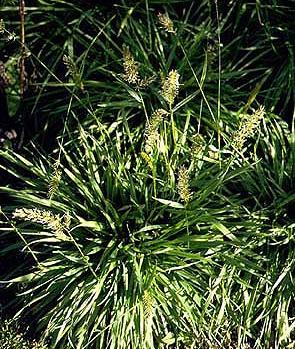
IP238 Sweet Vanilla Grass ( Anthoxanthum odoratum
)
Native Americans used large sweet grass to make baskets. A clumping, evergreen grass with soft green leaves about a ¼" wide by 8" long. Grass emits a delightful fragrance when cut or brushed against.
Fragrance remains in leaves for days after being cut. Flowers are silky green panicles that grow 15" above foliage and turn a showy yellow. Excellent border plant, it also holds up well to traffic and is often planted along edges of lawns, so that it's sweet fragrance can be released each time the lawn is mowed. Often used in cut arrangements for color and fragrance.
Fragrance remains in leaves for days after being cut. Flowers are silky green panicles that grow 15" above foliage and turn a showy yellow. Excellent border plant, it also holds up well to traffic and is often planted along edges of lawns, so that it's sweet fragrance can be released each time the lawn is mowed. Often used in cut arrangements for color and fragrance.
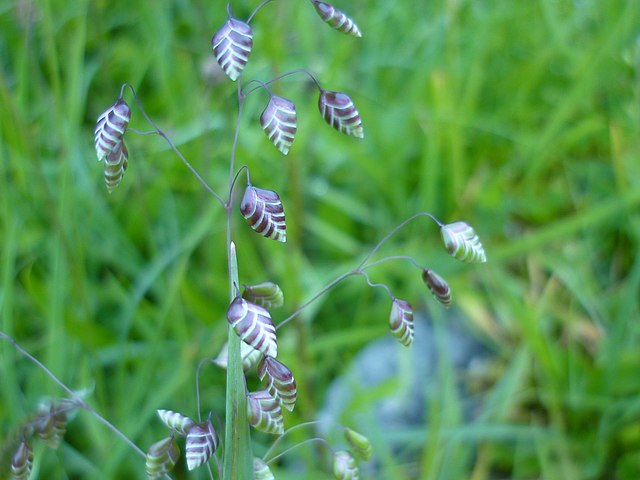
Image: Youngbohemian, CC BY-SA 4.0, via Wikimedia Commons
TWT272 Perennial Quaking Grass ( Briza Media )
A creeping, warm season ornamental grass which features a clump of narrow, erect, green leaves (1/4 to 1/2" wide) typically growing 12 to 15" tall. Tiny, greenish flowers appear in spring in loose, airy panicles atop stems rising well above the foliage clump to 24-36" tall. Flowers give way to flattened hop-like, purplish-maturing-to-tan seed heads which dangle on thread-like stems and quiver in the slightest breeze, thus giving rise to the common name.A delightful grass with a low to medium habit. Short clumps of deep-green leaves bear upright stems of delicate heart-shaped greenish-purple spikes in late spring and early summer. Excellent for cutting, fresh or dried. Foliage remains evergreen in mild regions. Perennial for zones 4-8.
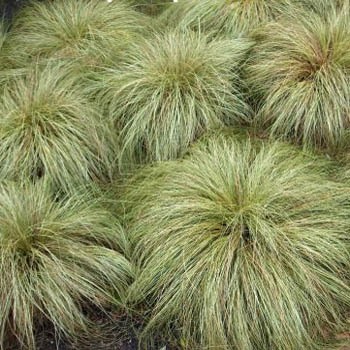
3654 Frosted Curls ( Carex comans )
Commonly called New Zealand Hair Sedge, this little dwarf sedge only reaches 12 inches in height. Enjoy the silvery, dense green clumps, in your pots and containers, beds and borders, or as groundcovers. Ornamental grasses such as Carex prefer well-drained soil and full sun to partial shade.
This ornamental sedge has a fine-texture with 1/16" wide, hair-like, almost cylindrical leaves that form dense tufts. With even a slight breeze, the iridescent, light green foliage will shimmer, and when the foliage has plenty of room to cascade over rocks, a container or a wall the ornamental grass gives the illusion of a waterfall.
Carex grass care includes trimming the plant back in the late winter or early spring leaving 1/3 of the plant in place. The plant can also be divided every few years in the early spring.
This ornamental sedge has a fine-texture with 1/16" wide, hair-like, almost cylindrical leaves that form dense tufts. With even a slight breeze, the iridescent, light green foliage will shimmer, and when the foliage has plenty of room to cascade over rocks, a container or a wall the ornamental grass gives the illusion of a waterfall.
Carex grass care includes trimming the plant back in the late winter or early spring leaving 1/3 of the plant in place. The plant can also be divided every few years in the early spring.
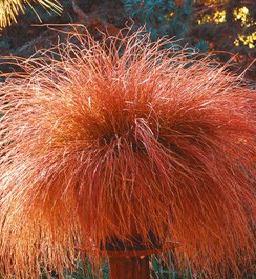
3647 Indian Summer ( Carex testacea )
New Zealand native, arching olive colored foliage turning brown, shimmering appearance, tolerates moist soils, grows about 16" tall, hardy to zone 7, annual in colder
zones.
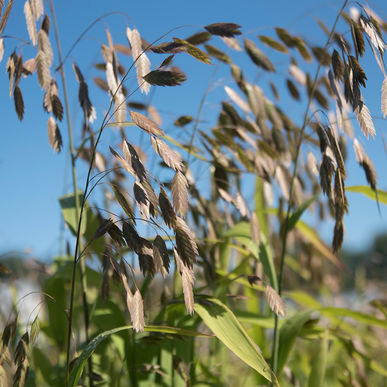
TWT155 Northern Sea Oats ( Chasmanthium latifolium
)
Slender stalks and spikes, likes shade, great fall and winter
garden presence, perennial growing 48" tall, hardy to zone 4.
Excellent cut flower, dried filler material.
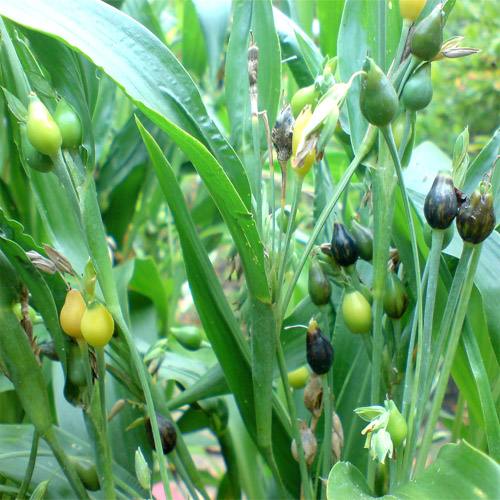
TWT195 Job's Tears ( Coix lachrymae )
We've had so many request for this hard to locate seed that we
had to make it available. For an interesting ornamental grass, try starting and enjoy this attractive grass that is known for its seeds.
Commonly called Job's Tears grass, Coix is a perennial grass only in climate zones 9 and 10, and it is grown as an annual in the cooler zones.
Ornamental grasses provide their own unique beauty to the landscape and Job's Tears is no exception with its slender, ribbon-like leaves and spikes of teardrop-like seeds.
The plant is well known for the seeds that are natural beads and have been used for centuries to create jewelry and rosaries.
Coix grass is native to Asia and is found along roadsides as well as cultivated for the grain that is edible and used in traditional Chinese herbal medicine.
Commonly called Job's Tears grass, Coix is a perennial grass only in climate zones 9 and 10, and it is grown as an annual in the cooler zones.
Ornamental grasses provide their own unique beauty to the landscape and Job's Tears is no exception with its slender, ribbon-like leaves and spikes of teardrop-like seeds.
The plant is well known for the seeds that are natural beads and have been used for centuries to create jewelry and rosaries.
Coix grass is native to Asia and is found along roadsides as well as cultivated for the grain that is edible and used in traditional Chinese herbal medicine.
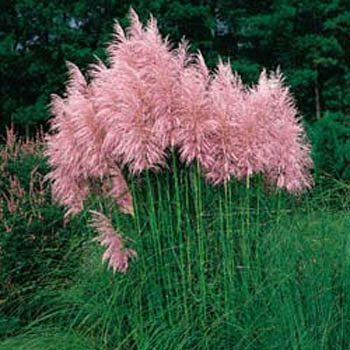
2520 Pink Pampas Grass ( Cortaderia Sellonia Pink
)
You can enjoy fresh green foliage topped by long, thick dusty-pink plumes when you grow these. These elegant ornamental grasses have "feather duster" plumes from late summer and throughout the fall!
The plumes are often cut and dried for indoor use, or they can be left on the plant for wonderful winter interest. Pampas Grass is not only attractive, but it also is very functional. It can be a stunning specimen plant in large landscapes, or it can be used to create screens or borders. These large ornamental grasses do need lots of room!
It is a low-maintenance plant. There is no need to spray for insects or any other bothersome garden pest. It will grow in most soils and responds favorably to frequent fertilization. To obtain good growth and plume production, pampas grass should be fertilized with a complete fertilizer (we recommend 8-8-8) at a rate of two pounds per 100 square feet four times each year.
Ornamental grass care also includes cutting out the brown, dead foliage in the late winter. Or, if significant frost damage occurs, the entire plant can be cut back to 2 feet from the ground. The grass blades are sharp, so care must be taken when pruning.Zones 7-10.
The plumes are often cut and dried for indoor use, or they can be left on the plant for wonderful winter interest. Pampas Grass is not only attractive, but it also is very functional. It can be a stunning specimen plant in large landscapes, or it can be used to create screens or borders. These large ornamental grasses do need lots of room!
It is a low-maintenance plant. There is no need to spray for insects or any other bothersome garden pest. It will grow in most soils and responds favorably to frequent fertilization. To obtain good growth and plume production, pampas grass should be fertilized with a complete fertilizer (we recommend 8-8-8) at a rate of two pounds per 100 square feet four times each year.
Ornamental grass care also includes cutting out the brown, dead foliage in the late winter. Or, if significant frost damage occurs, the entire plant can be cut back to 2 feet from the ground. The grass blades are sharp, so care must be taken when pruning.Zones 7-10.
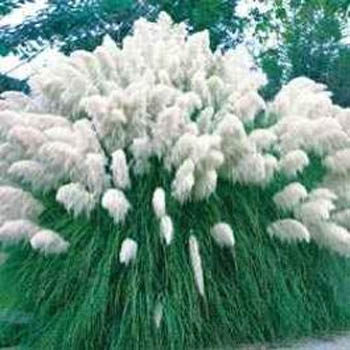
2521 White Pampas Grass ( Cortaderia Sellonia White
)
This magnificent plant thrives in full sun and hot climates. From seeds, it will take 2 or 3 years to bloom, but your patience is richly repaid by long-lived garden performance!
Pampas grass grows fairly fast, so it is an ideal choice for filling large, barren landscapes. It will also grow thick creating an effective privacy screen, wind break or sound barrier.
This grass has long, graceful blades and fluffy panicles that are beautiful. One of the favorite ornamental grasses, it is a classic and offers both color and texture in the landscape.
Like most ornamental grasses, it is pest-resistant. It is also highly drought-resistant and, once established, never needs watering. It will grow in most soils and responds favorably to frequent fertilization. To obtain good growth and plume production, pampas grass should be fertilized with a complete fertilizer (we recommend 8-8-8) at a rate of two pounds per 100 square feet four times each year. Ornamental grass care also includes cutting out the brown, dead foliage in the late winter. Or, if significant frost damage occurs, the entire plant can be cut back to 2 feet from the ground. The grass blades are sharp, so care must be taken when pruning.
Zones 7-10.
Pampas grass grows fairly fast, so it is an ideal choice for filling large, barren landscapes. It will also grow thick creating an effective privacy screen, wind break or sound barrier.
This grass has long, graceful blades and fluffy panicles that are beautiful. One of the favorite ornamental grasses, it is a classic and offers both color and texture in the landscape.
Like most ornamental grasses, it is pest-resistant. It is also highly drought-resistant and, once established, never needs watering. It will grow in most soils and responds favorably to frequent fertilization. To obtain good growth and plume production, pampas grass should be fertilized with a complete fertilizer (we recommend 8-8-8) at a rate of two pounds per 100 square feet four times each year. Ornamental grass care also includes cutting out the brown, dead foliage in the late winter. Or, if significant frost damage occurs, the entire plant can be cut back to 2 feet from the ground. The grass blades are sharp, so care must be taken when pruning.
Zones 7-10.
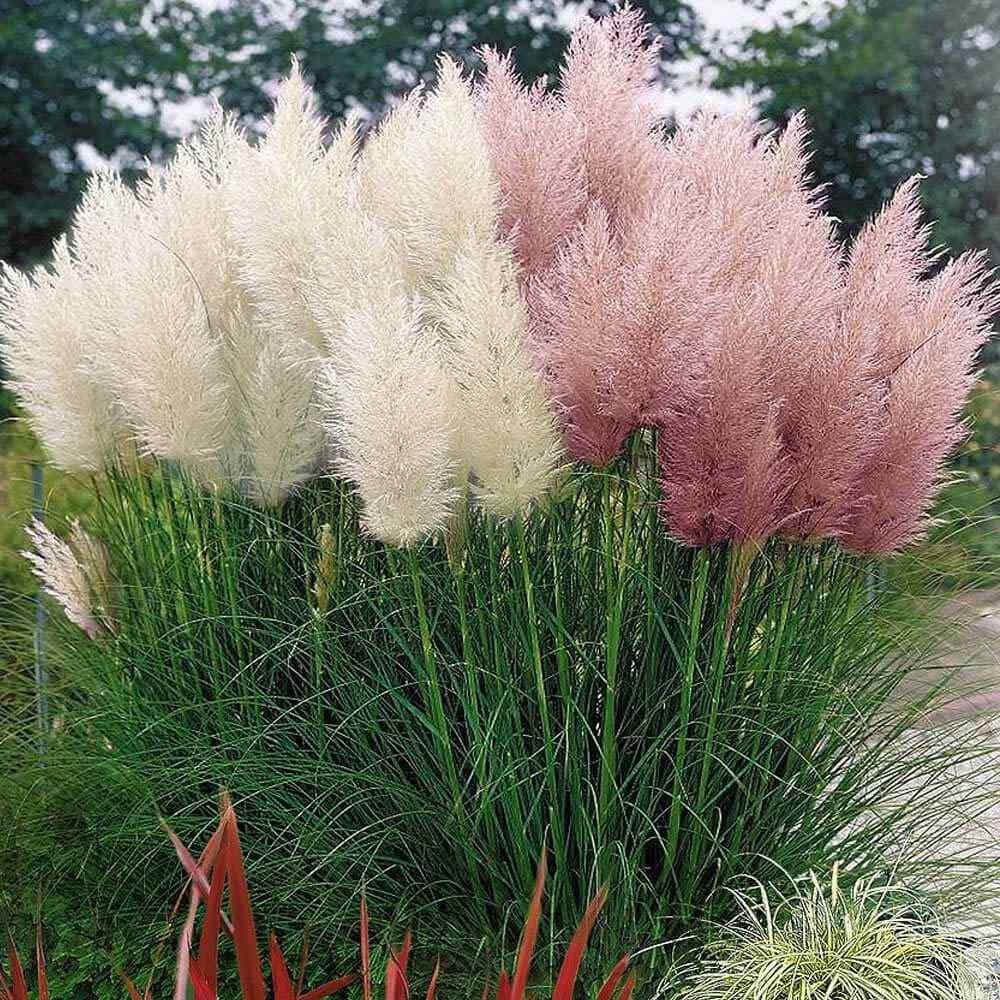
TWT228 Pampas Grass Mix ( Cortaderia mixture )
For a stately, tall ornamental grass that has a commanding presence, start Pampas Grass seeds, and enjoy its majestic beauty! This tall, ornamental grass is known for its silky, feathery plumes. Cortaderia selloana Pampas Grass will bloom for a long time in late summer and fall. Before the blooms are completely spent, many people choose to cut and dry the plumes for indoor use. This seed mix contains seeds for both white and pink Pampas Grass.
Pampas Grass is one of the largest ornamental grasses, and it is important to place the plants where they will have ample space, and they prefer a position in full sun. Ornamental Pampas Grass does require good drainage especially during the fall and winter. Ornamental grass care includes cutting out the brown, dead foliage in the late winter. Or, the entire plant can be cut back to 2 feet from the ground. The grass blades are sharp, so care must be taken when pruning.
Suited for zones 7-10, grows about 80 inches tall.
Pampas Grass is one of the largest ornamental grasses, and it is important to place the plants where they will have ample space, and they prefer a position in full sun. Ornamental Pampas Grass does require good drainage especially during the fall and winter. Ornamental grass care includes cutting out the brown, dead foliage in the late winter. Or, the entire plant can be cut back to 2 feet from the ground. The grass blades are sharp, so care must be taken when pruning.
Suited for zones 7-10, grows about 80 inches tall.
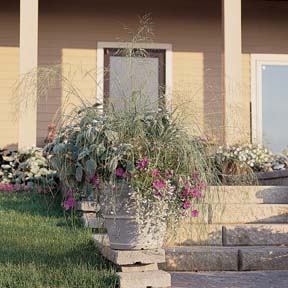
LET824 Wind Dancer ( Eragrostis elliotii var Wind
Dancer)
Graceful blue green leaf, plumes mature to straw color, drought
tolerant, for large pot or garden, perennial, Multiseed Pellets
contains 6-8 seeds per pellet. Grows 36" tall, hardy to zone
6.
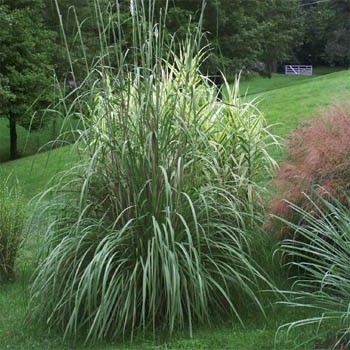
SF206 Giant Bent Awn Plume Grass ( Erianthus ravennae
)
Giant, gray green leaf, turning bronze in fall, 96" tall
silvery purple flower spikes, fluffy panicles persist thru
winter, perennial to zone 6.
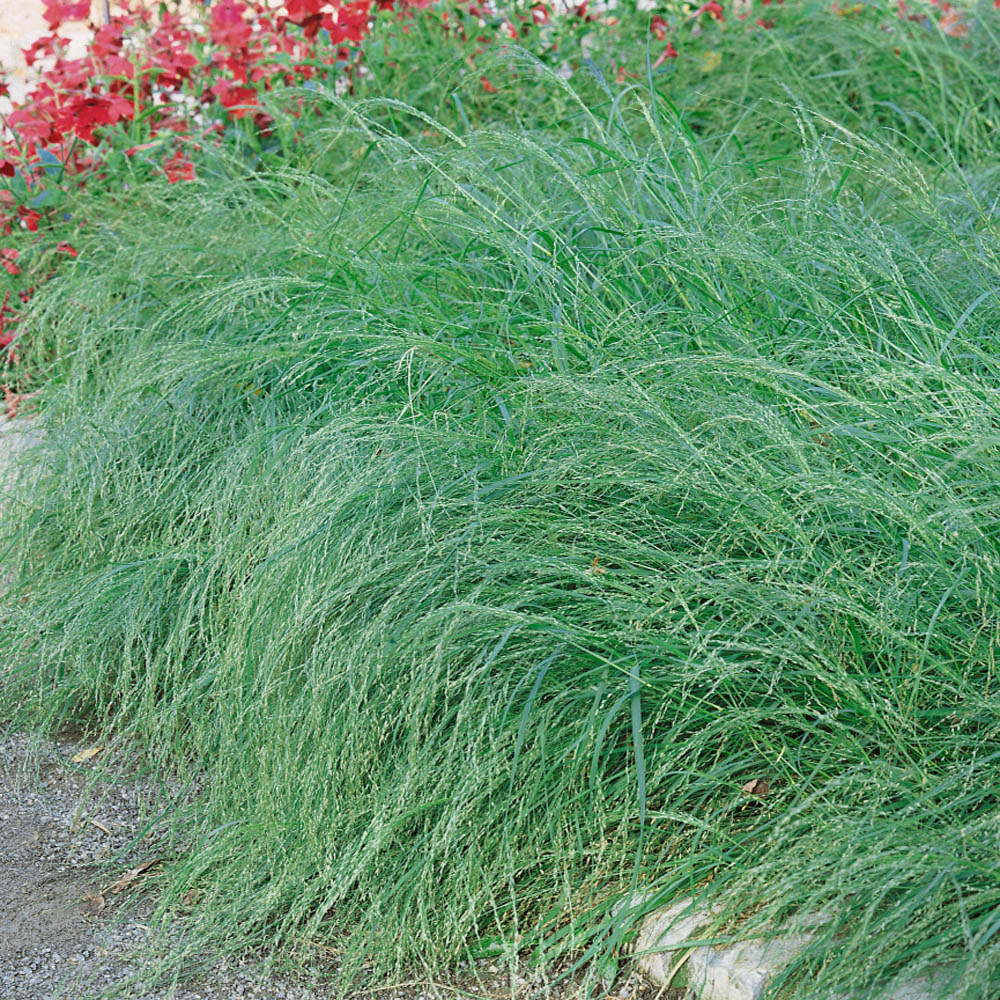
TGL052 Weeping Love Grass ( Eragrostis curvula )
A rapidly growing warm-season bunchgrass with narrow leaves emerging from a tight tuft with the tips almost touching the ground. The drooping leaf characteristic gives rise to the name "weeping" lovegrass. The plant itself rarely reaches above 12 inches; however, the seed heads reach a height of 30 to 40 inches and contain numerous small, fine seeds.
Weeping lovegrass is used as a temporary cover for erosion control purposes. It prefers a light-textured, welldrained soil, and will thrive on soils of low fertility. Climatic conditions determine its range of adaptation. Low winter temperatures will prevent regrowth and cause the grass to act as an annual or a short-lived perennial. Weeping lovegrass is distributed throughout the southern United States for erosion control and forage. Weeping lovegrass when fertilized properly will have good forage quality unless seedhead formation is allowed, upon which palatability declines rapidly.
Perennial for zones 6-10, grows 36-42 inches tall.
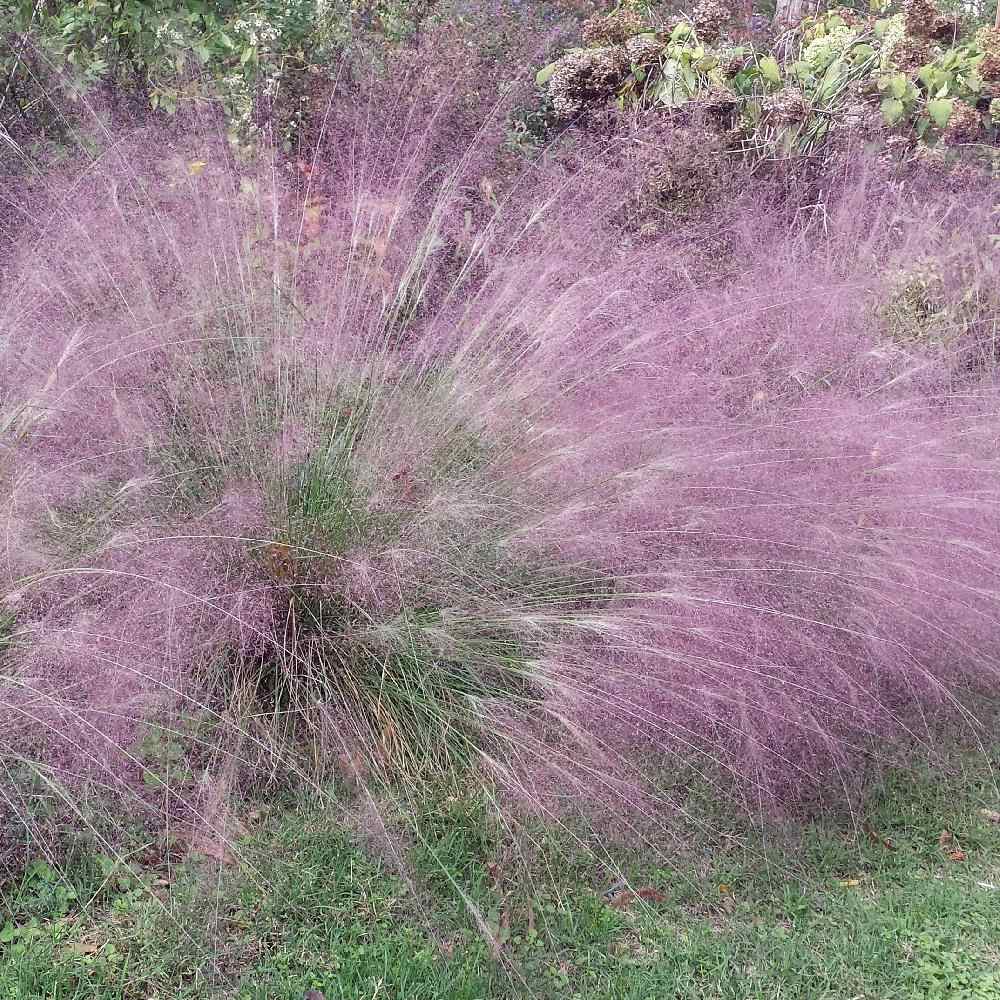
JB215 Cloud Grass ( Eragrostis spectabilis )
Also known as Purple Love Grass, a species of bentgrass, forms a hazy mist in late summer when its delicate, tiny flowers spread out in all directions. This plant is often cultivated for its light delicate heads that are used dried in floristry.
The airy seed-heads resemble clouds or sea foam which make a great addition to any flower garden. The ornamental grass has its best display when next to course textured plants or along fence lines. Agrostis nebulosa is very useful to fill in those difficult transitions in the garden. When Cloud Grass is fully mature, it reaches approximately18 inches tall & 12 inches wide blooming all summer long. Native to Portugal & Spain, but will grow in the U.S. in USDA Zones 3 - 10 as an annual ornamental grass. The flowers are great for fresh or dried bouquet and will turn tan as the seed-heads head in to Fall.
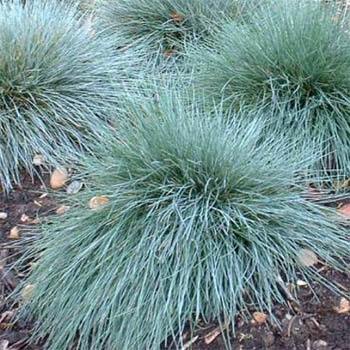
3575 Elijah Blue ( Festuca glauca )
Outstanding, icy blue coloration to this clumping ornamental grass holds up even through the heat of summer. Buff colored flowers create eye-catching contrast. Perfectly suited for edging borders or mass planting as a groundcover. Drought tolerant when established. Evergreen for year round color.
Full to part sun in well drained soil, hardy, grows 12" tall, perennial to zone 4.
Full to part sun in well drained soil, hardy, grows 12" tall, perennial to zone 4.
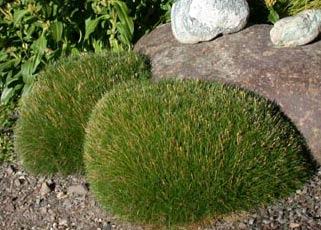
3565 Bearskin Fescue ( Festuca scoparia )
Evergreen pincushion mound, groundcover for sun or shade rock
garden, very appealing, hardy, grows 4" tall, perennial to zone
4.
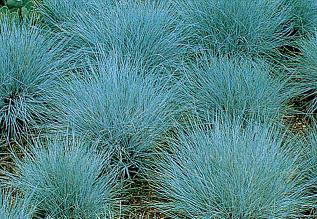
SF205 Glaucantha ( Festuca valesiaca )
Fine leafed blue, extra hardy, from Europe, perennial, grows
12" tall, hardy to zone 4.
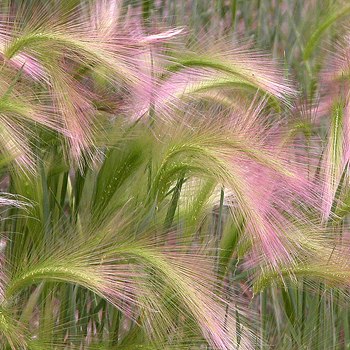
SF220 Foxtail Barley ( Hordeum jubatum )
Dazzling color, one of the most preferred ornamental grasses. Also commonly called Squirrel Tail Grass, prefers full sun and moist to dry conditions. In the wild, it can be found growing along the edges of marshes, poorly drained fields, pastures, and gravelly areas along roads and railroads. It even tolerates salt, but it cannot compete well with taller vegetation. Hordeum jubatum has gained popularity as an ornamental grass because of its highly attractive flower heads.
Hardy outside for zones 4-10, grows about 20" tall.
Hardy outside for zones 4-10, grows about 20" tall.
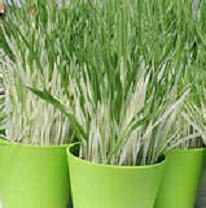
3293 Variegated Cat Grass ( Hordeum vulgare )
Green and white striped, wide leaf, scented, cats love it, fast growing, for container or
garden. A decorative plant even if you do not have cats.
Hardy outside to zone 5, grows about 12" tall.
Hardy outside to zone 5, grows about 12" tall.
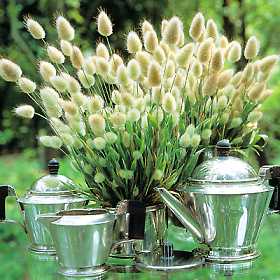
3568 Hares Tail Grass ( Lagurus ovatus )
It is difficult, for gardeners of all ages, to resist touching this flower’s fluffy head, which is as soft as a bunny’s tail! Compact but showy, this annual ornamental grass is easily grown in a border, for use as a cut flower, or in a container. Drought-tolerant once established with a dwarf habit. Annual, 6-12" tall.

IP182 Chinese Silver Grass ( Miscanthus sinensis )
Vigorous clump former, graceful plumes in late summer, likes
moisture in sun or shade, for landscape or cut/dried,
perennial, grows 72" tall, hardy to zone 4.
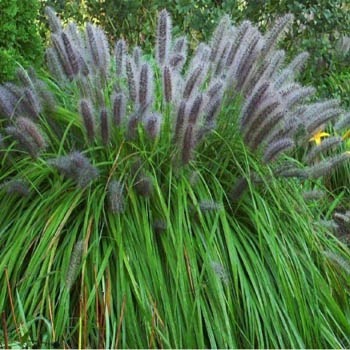
SF203 Moudry ( Pennisetum alopecuroides viridescens
)
Black foxtail-like flowers in fall, lush green foliage,
perennial, good cutting material, grows 36" tall, hardy to zone
4.
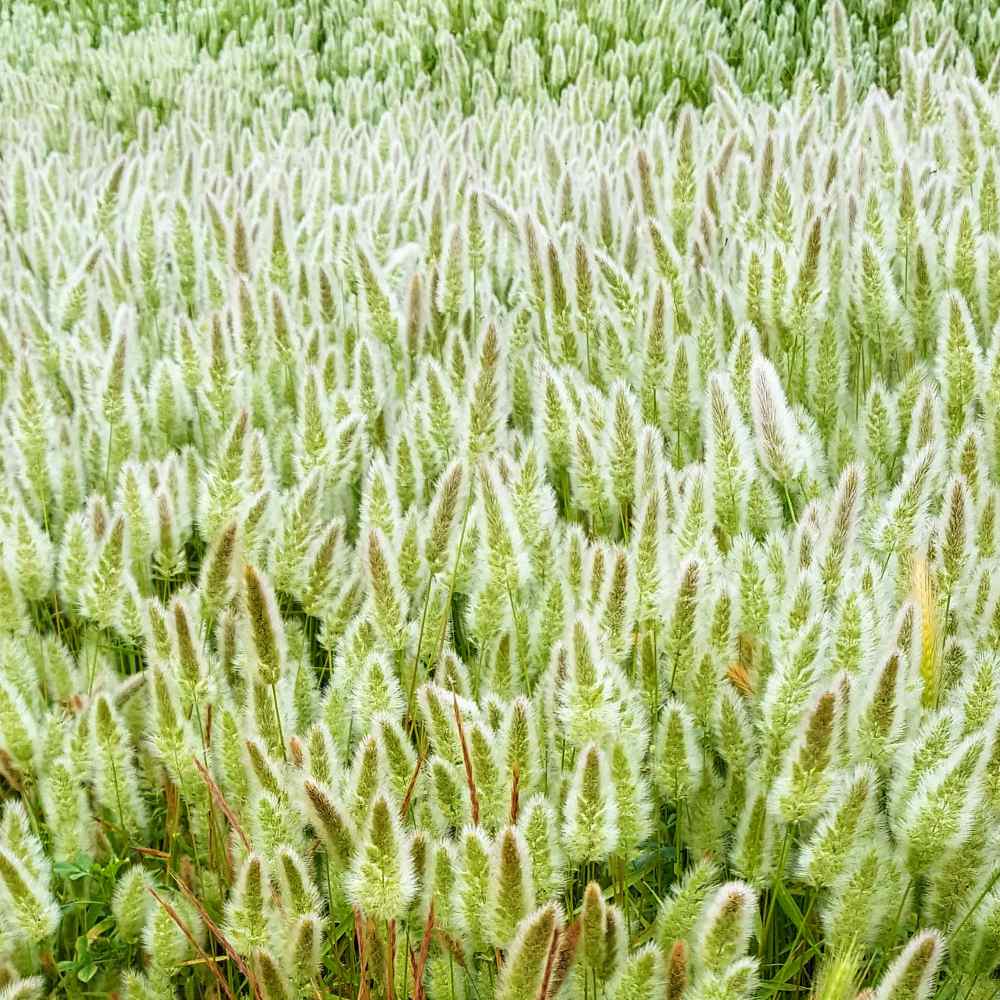
LET825 Rabbits Foot Grass ( Polypogon monspeliensis )
For a spring and early summer ornamental grass, start Polypogon monspeliensis seeds and enjoy this fast growing, attractive annual. Common names for this grass are Annual Rabbitsfoot Grass or Annual Beardgrass. This ornamental grass is not picky about soil, and it tolerates moist to wet soils where other grasses will not grow.
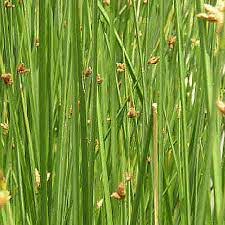
3727 Chairmaker's Rush ( Scirpus pungens )
The stems of this native rush were actually used for weaving sturdy chair seats in years gone by. This perennial is a widespread species and is used extensively in wetland restoration projects.
The strong triangular blades of this plant provided ribs for basket weaving, while the softer circular stems were often used for thatch or for finer weaving purposes. Though not a true rush, this member of the sedge family provides forage for water birds and small rodents. Occasionally, even the regal trumpeter swan and the Canada goose eat its foliage. A tough plant, it survives many types of hardship and is often used for erosion control or wetland restoration. The genus name "Scirpus" is the Latin term for bulrush.
Direct sow either in late fall or early spring. Press the seed into the surface of the soil, compacting the soil very firmly. For spring planting, mix the seeds with moist sand and store in the refrigerator for 60 days before planting. Keep the soil saturated until germination.
Growing: Water seedlings regularly until they become established. This plant prefers soil that is constantly moist and saturated, and thrives in shallow water or mud. It adapts to many soil types, including sand and gravel with adequate moisture. It will spread by rhizomes and self-seeding; mature plants can be divided. This plant makes an excellent choice for erosion control or wetland restoration, and provides forage and cover for birds and other wildlife. It also performs well in water gardens or on stream banks. For zones 2-11.
The strong triangular blades of this plant provided ribs for basket weaving, while the softer circular stems were often used for thatch or for finer weaving purposes. Though not a true rush, this member of the sedge family provides forage for water birds and small rodents. Occasionally, even the regal trumpeter swan and the Canada goose eat its foliage. A tough plant, it survives many types of hardship and is often used for erosion control or wetland restoration. The genus name "Scirpus" is the Latin term for bulrush.
Direct sow either in late fall or early spring. Press the seed into the surface of the soil, compacting the soil very firmly. For spring planting, mix the seeds with moist sand and store in the refrigerator for 60 days before planting. Keep the soil saturated until germination.
Growing: Water seedlings regularly until they become established. This plant prefers soil that is constantly moist and saturated, and thrives in shallow water or mud. It adapts to many soil types, including sand and gravel with adequate moisture. It will spread by rhizomes and self-seeding; mature plants can be divided. This plant makes an excellent choice for erosion control or wetland restoration, and provides forage and cover for birds and other wildlife. It also performs well in water gardens or on stream banks. For zones 2-11.
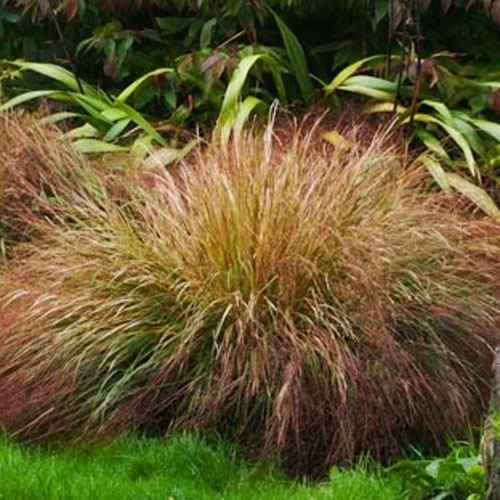
LET753 Pheasant Tails ( Stipa arundinacea )
Drought tolerant ornamental grasses add great texture and interest in the mixed border or xeriscape garden and this Pheasant's Tail grass is no exception. Grown from Stipa seeds, this clumping evergreen has narrow blades that arch gracefully and are streaked with coppery orange. In midsummer, pendent flowers open that are purplish green and give a misty appearance. Also called New Zealand Wind Grass, this drought tolerant ornamental grass is popular for its delightful form, colors, and drought tolerance where water conservation is becoming more and more important.
How To Grow Seeds: Many gardeners grow Stipa seeds in a cold frame for protection and hardiness. Start Pheasant's Tail grass seeds in the late winter or early spring. Sow the ornamental grass seeds in quality, well-draining seed starting mix and press the seeds into the soil. Keep the Stipa seeds moist until germination occurs. Once seedlings are large enough to handle, move into a pot and allow to grow on. Transplanting can be done in spring or summer after all frost danger has passed. Ornamental grass care includes trimming the plant back in late winter or early spring before new growth appears. Fertilize each spring. Propagation from division can be done in the spring as well.
A perennial for zones 8-10. Will form clumps 30 inches tall and 36 inches wide when mature outside or a good pot plant.
How To Grow Seeds: Many gardeners grow Stipa seeds in a cold frame for protection and hardiness. Start Pheasant's Tail grass seeds in the late winter or early spring. Sow the ornamental grass seeds in quality, well-draining seed starting mix and press the seeds into the soil. Keep the Stipa seeds moist until germination occurs. Once seedlings are large enough to handle, move into a pot and allow to grow on. Transplanting can be done in spring or summer after all frost danger has passed. Ornamental grass care includes trimming the plant back in late winter or early spring before new growth appears. Fertilize each spring. Propagation from division can be done in the spring as well.
A perennial for zones 8-10. Will form clumps 30 inches tall and 36 inches wide when mature outside or a good pot plant.
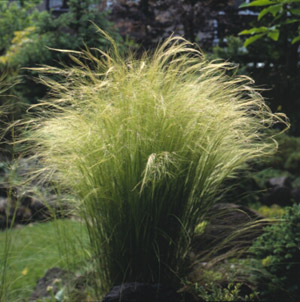
NW57 Angel Hair ( Stipa tenuissima )
A taller selection than Pony Tails for those who like long
legs, for mid border or cut, very angelic. Grows 36" tall,
hardy to zone 7.
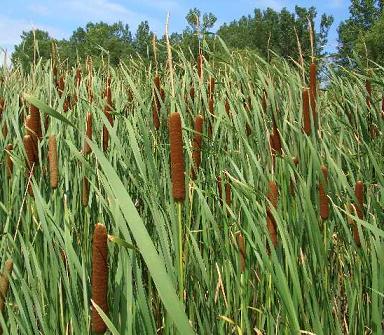
LET710 Narrow Leaf Cattail ( Typha angustifolia )
A unique and useful plant for wet areas. It can be used in water gardens, bog gardens, ponds. It will naturalize in wetland areas. Flower spikes are very popular additions to dried flower arrangements.
Narrowleaf cattail is easily identifiable from a distance because of its distinctive, narrow, blade-like green leaves (each to 5' long and 5/16" wide) and its stiff unbranched flower stalk which blooms from May to July and is topped by a poker-like, sausage-brown flower spike (5/8 to 1 1/4" diameter) which purportedly resembles a cattail.
A marginal, semi-aquatic, herbaceous perennial that typically grows from extensive creeping rhizomes to 3-7’ tall, often forming, over time, dense stands of robust spreading vegetation. It is native to wet, often mucky soils, including areas of shallow water to 12" deep, in fresh and brackish marshes, swamps, ditches, water margins of rivers and ponds, and along various other wetland areas in North America, Europe and Asia.
Narrowleaf cattail has year-round edible uses: (a) the peeled rhizomes can be cooked like potatoes or dried and made into protein-rich flour which can be added as a thickener for soups; (b) the young spring shoots are juicy with a nutty flavor and can be used as an asparagus substitute; (c) the young immature flowers can be boiled and eaten somewhat like corn on the cob; (d) the base of the leaves can be eaten like an artichoke; (e) the flowers can be eaten raw or cooked. Leaves are not edible but may be woven into mats, seats and baskets.
Typha can be used as a source of starch to produce ethanol. Because of their high productivity in northern latitudes, Typha are considered to be a bioenergy crop. A perennial plant for zones 2-11.
Narrowleaf cattail is easily identifiable from a distance because of its distinctive, narrow, blade-like green leaves (each to 5' long and 5/16" wide) and its stiff unbranched flower stalk which blooms from May to July and is topped by a poker-like, sausage-brown flower spike (5/8 to 1 1/4" diameter) which purportedly resembles a cattail.
A marginal, semi-aquatic, herbaceous perennial that typically grows from extensive creeping rhizomes to 3-7’ tall, often forming, over time, dense stands of robust spreading vegetation. It is native to wet, often mucky soils, including areas of shallow water to 12" deep, in fresh and brackish marshes, swamps, ditches, water margins of rivers and ponds, and along various other wetland areas in North America, Europe and Asia.
Narrowleaf cattail has year-round edible uses: (a) the peeled rhizomes can be cooked like potatoes or dried and made into protein-rich flour which can be added as a thickener for soups; (b) the young spring shoots are juicy with a nutty flavor and can be used as an asparagus substitute; (c) the young immature flowers can be boiled and eaten somewhat like corn on the cob; (d) the base of the leaves can be eaten like an artichoke; (e) the flowers can be eaten raw or cooked. Leaves are not edible but may be woven into mats, seats and baskets.
Typha can be used as a source of starch to produce ethanol. Because of their high productivity in northern latitudes, Typha are considered to be a bioenergy crop. A perennial plant for zones 2-11.
Ornamental Wheat
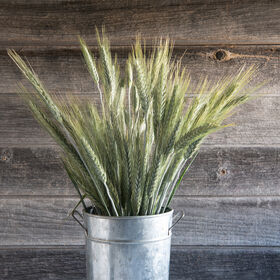
JB078 Silver Tip Wheat ( Triticosecale spp. )
Easy-to-grow grass with a fresh look. Green-to-white glumes and awns. 4" heads (not counting the awns). Easy textural element for fresh and dried bouquets. Vigorous wheat/rye cross. Ht. 24–36".

